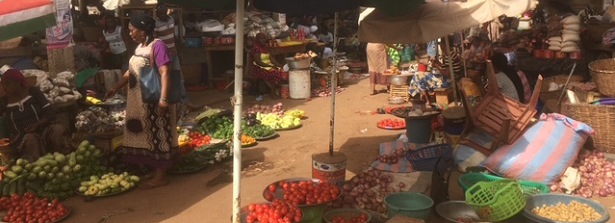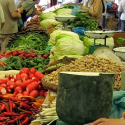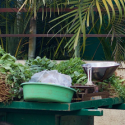Key challenges for post-COVID food systems

The COVID-19 pandemic has a large and decisive impact on public health, and generates major consequences for social relationships, economic development and food systems. Also, it fuels discussions on desired levels of globalization and ways we deal with natural resources. Considering the overarching effects, it is important to recognize major dilemma’s for post-COVID-19 agri-food policies for (a) choosing appropriate instruments and incentives, (b) maintaining an adequate balance between different policy domains, and for (c) weighing the importance of different societal objectives.
In this note, Ivo Demmers (WUR Director Food Security and Valuing Water Program) and Ruerd Ruben (WUR Professor Impact Assessment for Food Systems) focus on four food system dimensions that are most critical for outlining the (likely) impact of COVID-19 induced changes on agri-food systems’ performance, and outline the main challenges that have to be addressed during the post-COVID-19 recovery period. These dimensions refer to: (1) food production and employment, (2) food markets and trade, (3) food consumption and diets, and (4) food policies.
1. Challenges for food production and employment
In the short run, agricultural production is mostly constrained by declining demand (due to economic lockdowns and COVID-19 layoffs that lead to rising unemployment and income loss), but in the medium run also access to key input (seeds, fertilizers and pesticides) and rural credit might equally become a limiting factor. Food safety and specifically the thread of zoonotic diseases will influence the design of production systems. Some argue that the current momentum provides opportunities for a shift towards agroecological approaches to food production, while others advocate for sustainable intensification and circular and climate-smart food production systems. Due to COVID-19 effects, food systems’ resilience is weakened and therefore is more vulnerable to additional shocks (e.g. pests) or gradual changes (such as climate change), posing additional risks to maintain food security.
In the case that rising urban unemployment leads to return migration towards rural areas, more labour-intensive production systems can become competitive. Labour mobilization tends to be easier for smallholder farmers, whereas medium-scale farmers rely more on (semi-)intensive production systems. Otherwise, low-cost provision of cheap food to urban consumers might ask for larger scale commercial farming and reliance on high-yielding inputs. Depending on the duration of the economic lockdown, farm consolidation is likely to take place. Only massive cash transfer programs will be able to consolidate local food demand. Ideally these could contribute to the development of local food processing industry hence creating long lasting additional employment.
2. Challenges for food markets and trade
After the COVID-19 pandemic, interest in shorter supply chains and national food security is increasing. Countries and companies try to diversify their sourcing locations in order to reduce risks, and some supply chains are fully shifted towards emergency provision of key medical supplies. Local provision of “critical” products might include medical supplies, health care equipment, and basic food. This has important implications for the costs of food, since countries might refrain from their comparative advantage for specializing in large-scale production of particular foods while relying on interregional and international trade for guaranteeing access to a wider range of commodities.
Another major challenge refers to the possibilities for maintaining stable food prices for poor consumers, that largely depend on access to food markets that are sourced through open and transparent trade flows. After the COVID-19 crisis, trade finance for commercial transactions has become especially limited, and larger companies (with more resources) seem to be better able to maintain their operations.
Getting finance to the large number of traders and SMEs that dominate local food supply chains proved to be rather complicated. Some argue that digital devices might be helpful to speed up information exchange on markets and client reliability. For local wet markets that provide the poorest consumers with access to basic foods and rely heavily on informal social networks, it becomes important to guarantee food safety requirements and improve their internal spatial organization.
3. Challenges for food consumption and diets
With the COVID-19 pandemic, we notice important changes in food consumption patterns and diet choices. Sales of (semi-)processed and storable foods strongly increase, and preferences for fresh and healthy fruits and vegetables are rising as well. Prices for (imported) food staples such as rice and wheat are plummeting, whereas future prices for commodities like coffee, cocoa and oil are decreasing. In the same vein, intake of animal products is stagnating due to food safety concerns. Awareness of the benefits of a healthier diet and lifestyle might also be raised by reports of higher level of casualties due to COVID-19 amongst people suffering from obesity.
Many people are willing to spend a larger share of their income on foods, but most poor households cannot afford this. Therefore, inequality in food consumption is likely to increase. Since sales through food services and restaurants are prohibited in many places, on-line purchase of food and home delivery are booming. In addition to the youth, elderly people start using food apps and become increasingly engaged in e-commerce.
4. Challenges for food policies
In many countries the government is taking a leading role for mitigating COVID-19 impact. This starts with centralized health care services, and is rapidly extended towards the provision of unemployment subsidies (cash vouchers) and transitory business credit facilities (tax holidays; loan defaults, etc.). Since this crisis is not originating in the real economy, public demand stimulation and company cash support are used to reduce spill-over effects.
Interestingly enough, many public policies are guided by technical criteria (i.e. flattening the curve; reducing shopping contacts; etc.) whereas more attention might be given to behavioural change incentives that can be used to influence health-seeking behaviour and food choices. There is general recognition of the leading role of the public sector in regulating health care services, school attendance, distance working and leisure activities. Moreover, local collective action initiatives and innovative solutions by companies are flourishing in response to public regulation These could prove valuable lessons in flexibility and entrepreneurship that should be included in designing transitions towards more resilient, sustainable food systems. It is interesting to see whether public guidance of common property issues (climate change, biodiversity conservation, etc.) remains to receive broad civic confidence after the crisis.
Outlook
It is clear that the COVID-19 pandemic raises attention for many important challenges for agri-food systems in different parts of the world. It is still rather unclear, however, whether this will lead to accelerated structural changes or a marginal adaptation to a “new normal”.
Given the simultaneous changes taking place in each of the four agri-food domains, it is important to identify some key conditions for a coordinated and effective response to the COVID-19 crisis. Therefore, attention should be given to three related strategic issues:
- Responding to rapidly changing circumstances and gaining wide societal support for crisis mitigation and subsequent structural transformation strategies requires broad interdisciplinary cooperation between a wide range of technical and behavioural disciplines as well as between public and private actors.
- Designing policy pathways for post-COVID-19 agri-food systems is likely to be based on a combination of immediate, no-regret, steps and long-term perspectives that rely on incentives for motivating and engaging stakeholders and creating civic constituency.
- Recognizing opportunities for reaching synergies or overcoming trade-off between key food system objectives (access to healthier diets, sustainable food production, and inclusive value chains) can be based on dovetailing positive support measures (pull) with tax constraints to control negative externalities (pull).







